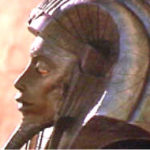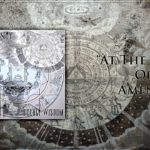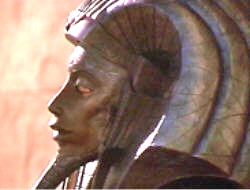by Andrew Collins
Extracted from New Dawn No.40
(January-February, 1997)
from AndrewCollins Website
| Is civilization the legacy of a race of human angels known as Watchers and Nephilim? Andrew Collins, author of FROM THE ASHES OF ANGELS, previews his history of angels and fallen angels and traces their origin back to an extraordinarily advanced culture that entered the Near East shortly after the end of the last Ice Age. |
Angels are something we associate with beautiful Pre-Raphaelite and renaissance paintings, carved statues accompanying gothic architecture and supernatural beings who intervene in our lives at times of trouble.
For the last 2000 years this has been the stereotypical image fostered by the Christian Church.
But what are angels?
Where do they come from, and what have they meant to the development of organized religion?
Many people see the Pentateuch, the first five books of the Old Testament, as littered with accounts of angels appearing to righteous patriarchs and visionary prophets.
Yet this is simply not so.
There are the three angels who approach Abraham to announce the birth of a son named Izaac to his wife Sarah as he sits beneath a tree on the Plain of Mamre. There are the two angels who visit Lot and his wife at Sodom prior to its destruction.
There is the angel who wrestles all night with Jacob at a place named Penuel, or those which he sees moving up and down a ladder that stretches between heaven and earth. Yet other than these accounts, there are too few examples, and when angels do appear the narrative is often vague and unclear on what exactly is going on.
For instance, in the case of both Abraham and Lot the angels in question are described simply as ‘men’, who sit down to take food like any mortal person.
Influence of the Magi
It was not until post-exilic times – i.e. after the Jews returned from captivity in Babylon around 450 BC – that angels became an integral part of the Jewish religion.
It was even later, around 200 BC, that they began appearing with frequency in Judaic religious literature. Works such as the Book of Daniel and the apocryphal Book of Tobit contain enigmatic accounts of angelic beings that have individual names, specific appearances and established hierarchies. These radiant figures were of non-Judaic origin. All the indications are that they were aliens, imports from a foreign kingdom, namely Persia.
The country we now today as Iran might not at first seem the most likely source for angels, but it is a fact that the exiled Jews were heavily exposed to its religious faiths after the Persian king Cyrus the Great took Babylon in 539 BC.
These included not only Zoroastrianism, after the prophet Zoroaster or Zarathustra, but also the much older religion of the Magi, the elite priestly caste of Media in north-west Iran. They believed in a whole pantheon of supernatural beings called ahuras, or ‘shining ones’, and daevas – ahuras who had fallen from grace because of their corruption of mankind.
Although eventually outlawed by Persia, the influence of the Magi ran deep within the beliefs, customs and rituals of Zoroastrianism.
Moreover, there can be little doubt that Magianism, from which we get terms such as magus, magic and magician, helped to establish the belief among Jews not only of whole hierarchies of angels, but also of legions of fallen angels – a topic that gains its greatest inspiration from one work alone – the Book of Enoch.
The Book of Enoch
Compiled in stages somewhere between 165 BC and the start of the Christian era, this so-called pseudepigraphal (i.e. falsely attributed) work has as its main theme the story behind the fall of the angels.
Yet not the fall of angels in general, but those which were originally known as ‘Œrin (‘Œr in singular), ‘those who watch‘, or simply ‘watchers‘ as the word is rendered in English translation.
The Book of Enoch tells the story of how 200 rebel angels, or Watchers, decided to transgress the heavenly laws and ‘descend’ on to the plains and take wives from among mortal kind. The site given for this event is the summit of Hermon, a mythical location generally association with the snowy heights of Mount Hermon in the Ante-Lebanon range, north of modern-day Palestine (but see below for the most likely homeland of the Watchers).
The 200 rebels realize the implications of their transgressions, for they agree to swear an oath to the effect that their leader Shemyaza would take the blame if the whole ill-fated venture went terribly wrong.
After their descent to the lowlands, the Watchers indulge in earthly delights with their chosen ‘wives’, and through these unions are born giant offspring named as Nephilim, or Nefilim, a Hebrew word meaning ‘those who have fallen’, which is rendered in Greek translations as gigantes, or ‘giants‘.
Heavenly Secrets
In between taking advantage of our women, the 200 rebel angels spent their time imparting the heavenly secrets to those who had ears to listen.
One of their number, a leader named Azazel, is said to have ‘taught men to make swords, and knives, and shields, and breastplates, and made known to them the metals (of the earth) and the art of working them’, indicating that the Watchers brought the use of metal to mankind. He also instructed them on how they could make ‘bracelets’ and ‘ornaments’ and showed them how to use ‘antimony’, a white brittle metal employed in the arts and medicine.
To the women Azazel taught the art of ‘beautifying’ the eyelids, and the use of ‘all kinds of costly stones’ and ‘colouring tinctures’, presupposing that the wearing of make-up and jewellery was unknown before this age. In addition to these crimes, Azazel stood accused of teaching women how to enjoy sexual pleasure and indulge in promiscuity – a blasphemy seen as ‘Godlessness’ in the eyes of the Hebrew story-tellers.
Other Watchers stood accused of revealing to mortal kind the knowledge of more scientific arts, such as astronomy, the knowledge of the clouds, or meteorology; the ‘signs of the earth’, presumably geodesy and geography, as well as the ‘signs’, or passage, of the celestial bodies, such as the sun and moon. Their leader, Shemyaza, is accredited with having taught ‘enchantments, and root-cuttings’, a reference to the magical arts shunned upon by most orthodox Jews.
One of their number, Pˆnˆm–e, taught ‘the bitter and the sweet‘, surely a reference to the use of herbs and spices in foods, while instructing men on the use of ‘ink and paper’, implying that the Watchers introduced the earliest forms of writing. Far more disturbing is Kƒsdejƒ, who is said to have shown ‘the children of men all the wicked smitings of spirits and demons, and the smitings of the embryo in the womb, that it may pass away’. In other words he taught women how to abort babies.
These lines concerning the forbidden sciences handed to humanity by the rebel Watchers raises the whole fundamental question of why angels should have possessed any knowledge of such matters in the first place.
Why should they have needed to work with metals, use charms, incantations and writing; beautify the body; employ the use of spices, and know now to abort an unborn child? None of these skills are what one might expect heavenly messengers of God to possess, not unless they were human in the first place.
In my opinion, this revelation of previously unknown knowledge and wisdom seems like the actions of a highly advanced race passing on some of its closely-guarded secrets to a less evolved culture still striving to understand the basic principles of life.
More disconcerting were the apparent actions of the now fully grown Nephilim, for it says:
And when men could no longer sustain them, the giants turned against them and devoured mankind. And they began to sin against birds, and beasts, and reptiles, and fish, and to devour one another’s flesh, and drink the blood. Then the earth laid accusation against the lawless ones.
By now the cries of desperation from mankind were being heard loud and clear by the angels, or Watchers, who had remained loyal to heaven. One by one they are appointed by God to proceed against the rebel Watchers and their offspring the Nephilim, who are described as ‘the bastards and the reprobates, and the children of fornication’. The first leader, Shemyaza, is hung and bound upside down and his soul banished to become the stars of the constellation of Orion.
The second leader, Azazel, is bound hand and foot, and cast for eternity into the darkness of a desert referred to as D–dƒˆl. Upon him are placed ‘rough and jagged rocks’ and here he shall forever remain until the Day of Judgment when he will be ‘cast into the fire’ for his sins.
For their part in the corruption of mankind, the rebel Watchers are forced to witness the slaughter of their own children before being cast into some kind of heavenly prison, seen as an ‘abyss of fire’.
Seven Heavens
The patriarch Enoch then enters the picture and, for some inexplicable reason, is asked to intercede on behalf of the incarcerated rebels.
He attempts to reconcile them with the angels of heaven, but fails miserably. After this the Book of Enoch relates how the patriarch is carried by angels over mountains and seas to the ‘seven heavens’.
Here he sees multitudes of angelic beings watching stars and other celestial bodies in what appear to be astronomical observatories. Others tend orchards and gardens that have more in common with an Israeli kibbutz than an ethereal realm above the clouds. Elsewhere in ‘heaven’ is Eden, where God planted a garden for Adam and Eve before their fall – Enoch being the first mortal to enter this domain since their expulsion.
Finally, during the life of Enoch’s great-grandson, Noah, the Great Flood covers the land and destroys all remaining traces of the giant race.
Thus ends the story of the Watchers.
The Sons of God
What are we to make of the Book of Enoch? Are its accounts of the fall of the Watchers and the visits to heaven by the patriarch Enoch based on any form of historical truth?
Scholars would say no. They believe it to be a purely fictional work inspired by the Book of Genesis, in particular two enigmatic passages in Chapter 6.
The first, making up Verses 1 and 2, reads as follows:
And it came to pass, when men began to multiply on the face of the ground, and daughters were born unto them, that the sons of God saw the daughters of men that they were fair; and they took them wives of all that they chose.
By ‘sons of God ‘ the text means heavenly angels, the original Hebrew being bene ha-elohim.
In Verse 3 of Chapter 6 God unexpectedly pronounces that his spirit cannot remain in men for ever, and that since humanity is a creation of flesh its life-span will henceforth be shortened to ‘an hundred and twenty years’. Yet in Verse 4 the tone suddenly reverts to the original theme of the chapter, for it says:
The Nephilim were in the earth in those days, and also after that, when the sons of God came in unto the daughters of men, and they bare children to them: the same were the mighty men which were of old, the men of renown.
As the Pentateuch is considered to have been written by Moses the lawgiver in c. 1200 BC, it is assumed that the lines of Genesis 6 influenced the construction of the Book of Enoch, not the other way round. Despite this obvious assumption on the part of Hebrew scholars, there is ample evidence to show that much of Genesis was written after the Jews return from captivity in Babylon during the mid-fifth century BC.
If this was the case, then there is no reason why the lines of Genesis 6 could not have been tampered with around this time. In an attempt to emphasize the immense antiquity of the Book of Enoch, Hebrew myth has always asserted that it was originally conveyed to Noah, Enoch’s great grandson, after the Great Flood, i.e. long before the compilation of Genesis.
This claim of precedence over the Pentateuch eventually led the Christian theologian St Augustine (AD 354-430) to state that the Book of Enoch was too old (ob nimiam antiquitatem) to be included in the Canon of Scripture!
Roots of the Nephilim
There is another enigma contained within the lines of Genesis 6, for its appears to embody two entirely different traditions.
Look again at the words of Verse 2. They speak of the Sons of God coming unto the Daughters of Men, while in contrast Verse 4 states firmly:
‘The Nephilim were in the earth in those days and also after that when the sons of God came in unto the daughters of men (author’s emphasis)’.
And also after that…
The meaning seemed clear enough: there were two quite separate traditions entangled here – one concerning the fallen race known to the early Israelites as the Nephilim (mentioned elsewhere in the Pentateuch as the progenitors of a race of giants called Anakim), and the other concerning the bene ha-elohim, the Sons of God, who are equated directly with the Watchers in Enochian tradition.
Theologians are aware of this dilemma, and get around the problem by suggesting that the angels fell from grace twice – once through pride and then again through lust. It seems certain that the term Nephilim was the original Hebrew name of the fallen race, while bene ha-elohim was a much later term – plausibly from Iran – that entered Genesis 6 long after its original compilation.
In spite of the contradictions surrounding Genesis 6, its importance is clear enough, for it preserved the firm belief among the ancestors of the Jewish race that at some point in the distant past a giant race had once ruled the earth.
So if the Watchers and the Nephilim really had inhabited this world,
then who or what were these seemingly physical beings?
Where did they come from?
What did they look like?
Where did they live and what was their ultimate fate?
The Book of Enoch was a vital source of knowledge with regard to their former existence, but I needed more – other less tainted accounts of this apparent race of human beings.
Then came an important break.
The Dead Sea Connection
Hebrew scholars had long noted the similarities between some of the reactionary teachings in the Book of Enoch and the gospels according to the Essenes – a fundamental, yet very righteous religious community spoken of by classical scholars as having existed on the western shores of the Dead Sea.
This connection was strengthened after 1947 when it was realized that among the Dead Sea Scrolls, now considered to have been written by the Essenes, were various fragments of texts belonging to several copies of the Book of Enoch.
Up until this time the only complete manuscript copies available to the literary world had been various copies written in the Ethiopian written language of Ge’ez, the first of which had been brought back to Europe by the Scottish explorer and known Freemason James Bruce of Kinnaird following his famous travels in Abyssinia between 1769 and 1772.
Not only did the Dead Sea Scrolls confirm the authenticity of the Book of Enoch, but they also showed that it had been held in great esteem by the Essene community at Qumran, who may even have been behind its original construction sometime after 165 BC. More importantly, Hebrew scholars also began to identify various other previously unknown tracts of an ‘Enochian’ flavour among the Dead Sea corpus, and these included further references to the Watchers and their offspring the Nephilim.
Many of these individual fragments were eventually realized by Dead Sea scholar J. T. Milik to be extracts from a lost work called the Book of Giants. Previously this had only been known from isolated references in religious texts appertaining to the Manichaeans, a heretical gnostic faith that swept across Europe and Asia, as far as China and Tibet, from the third century AD onwards.
The Book of Giants continues the story told in the Book of Enoch, relating how the Nephilim had coped with knowing that their imminent destruction was due to the improprieties of their Watcher fathers.
Reading this ancient work allows the reader a more compassionate view of the Nephilim, who come across as innocent bystanders in a dilemma beyond their personal control.
Visage Like A Viper
Yet aside from this still very fragmentary treatise, other Enochian texts have surfaced among the Dead Sea Scrolls which in my opinion are just as important. One of these is the Testament of Amram.
Amram was the father of the lawgiver Moses, although any biblical time-frame to this story is irrelevant.
What is much more significant is the appearance of the two Watchers who appear to him in a dream-vision as he rests in his bed, for as the heavily reconstructed text reads:
[I saw Watchers] in my vision, the dream-vision. Two (men) were fighting over me, saying… and holding a great contest over me. I asked them,
‘Who are you, that you are thus empo[wered over me?’ They answered me, ‘We] [have been em]powered and rule over all mankind.’ They said to me, ‘Which of us do yo[u choose to rule (you)?’ I raised my eyes and looked.]
[One] of them was terr[i]fying in his appearance, [like a s]erpent, [his] c[loa]k many-coloured yet very dark…
[And I looked again], and… in his appearance, his visage like a viper, and [wearing…] [exceedingly, and all his eyes…].
The text identifies this last Watcher as Belial, the Prince of Darkness and King of Evil, while his companion is revealed as Michael, the Prince of Light, who is also named as Melchizedek, the King of Righteousness.
It is, however, Belial’s frightful appearance that took my attention, for he is seen as terrifying to look upon and like a ‘serpent’, the very synonym so often used when describing both the Watchers and the Nephilim. If the textual fragment had ended here, then I would not have known why this synonym had been used by the Jewish scribe in question.
Fortunately, however, the text goes on to say that the Watcher possessed a visage, or face, ‘like a viper’. Since he also wears a cloak ‘many-coloured yet very dark’, I had also to presume that he was anthropomorphic, in other words he possessed human form.
Visage like a viper…
What could this possibly mean?
How many people do you know with a ‘visage like a viper’?
For over a year I could offer no suitable solution to this curious metaphor.
Then, by chance, I happened to overhear something on a national radio station that provided me with a simple, though completely unexpected answer. In Hollywood, Los Angeles, there is a club called the Viper Room. It is owned by actor and musician Johnny Depp, and in October 1993 it hit the headlines when up-coming actor River Phoenix tragically collapsed and died as he left the club following a night of over-indulgence.
In the media publicity that inevitably surrounded this drugs-related incident, it emerged that the Viper Room gained its name many years beforehand when it had been a jazz haunt of some renown.
Story goes that the musicians would take the stage and play long hours, prolonging their creativity and concentration by smoking large amounts of marijuana.
Apparently, the long term effects of this drug abuse, coupled with exceedingly long periods without food and sleep, would cause their emaciated faces to appear hollow and gaunt, while their eyes would close up to become just slits. Through the haze of heavy smoke, the effect was to make it seem as if the jazz musicians had faces like vipers, hence the name of the club.
This amusing anecdote sent my mind reeling and enabled me to construct a mental picture of what a person with a ‘visage like a viper’ might look like; their faces would appear long and narrow, with prominent cheekbones, elongated jawbones, thin lips and slanted eyes like those of many East Asian racial types. Was this the solution as to why both the Watchers and Nephilim were described as walking serpents?
It seemed as likely a possibility as any, although it was also feasible that their serpentine connection related to their accredited magical associations and capabilities, perhaps even their bodily movements and overall appearance.
The Appearance of Feathers
Another important reference to the appearance of Watchers comes from the so-called Secrets of the Book of Enoch, also known as 2 Enoch, a kind of sequel to the original work written in Greek and dating to the first century AD.
The passage refers to the unexpected arrival of two Watchers as Enoch rests on his bed:
And there appeared to me two men very tall, such as I have never seen on earth. And their faces shone like the sun, and their eyes were like burning lamps; and fire came forth from their lips. Their dress had the appearance of feathers:… [purple], their wings were brighter than gold; their hands whiter than snow. They stood at the head of my bed and called me by my name.
White skin (often ruddied ‘as red as a rose’), tall stature and facial radiances ‘like the sun’ all recur frequently in connection with the appearance of angels and Watchers in Enochian and Dead Sea literature.
Yet what was this reference to their dress having ‘the appearance of feathers‘? Might it relate in some way to the ‘cloak’ worn by the Watcher named Belial who appears in the Amram story, which was said to have been ‘many-coloured yet very dark’, precisely the effect one might expect from a coat of black feathers, like those belonging to crows or vultures perhaps?
In spite of the fact that Christian art has invariably portrayed angels with wings, this tradition goes back no further than the third or fourth century AD. Before this time true angels (Cherubim and Seraphim did have multiple sets of wings) appeared in the likeness of ‘men’, a situation that often prompted textual translators to add wings on to existing descriptions of angels.
This has almost certainly been the case in the above account taken from 2 Enoch, which was re-copied many times during the early years of Christianity.
With this observation in mind, I felt that the statement concerning the Watchers dress having ‘the appearance of feathers‘ was very revealing indeed. It also seemed like an over-sight on the part of the scribe who conveyed this story into written form, for having added wings to the description of the two ‘men’, why bother saying they wore garments of feathers?
Surely this confusion between wings and feather coats could have been edited to give the Watchers a more appropriate angelic appearance.
Bird Shamans
Somehow I knew it was a key to unlocking this strange mystery, for it suggested that, if the Watchers had indeed been human, then they may have adorned themselves in garments of this nature as part of their ceremonial dress.
The use of totemic forms, such as animals and birds, has always been the domain of the shaman, the spirit walkers of tribal communities. In many early cultures the soul was said to have taken the form of a bird to make its flight from this world to the next, which is why it is often depicted as such in ancient religious art.
This idea may well have stemmed from the widely-held belief that astral flight could only be achieved by using ethereal wings, like those of a bird, something that almost certainly helped inspire the idea that angels, as messengers of God, should be portrayed with wings in Christian iconography.
To enhance this mental link with his or her chosen bird, shamans would adorn their bodies with a coat of feathers and spend long periods of time studying its every movement. They would enter its natural habitat and watch every facet of its life – its method of flight, its eating habits, its courtship rituals and its actions on the ground. In doing so they would hope to become as birds themselves, an alter-personality adopted on a semi-permanent basis.
Totemic shamanism is more-or-less dependent on the indigenous animals or birds present in the locale of the culture or tribe, although in principle the purpose has always been the same – using this mantle to achieve astral flight, divine illumination, spirit communication and the attainment of otherworldly knowledge and wisdom.
So could the Watchers and Nephilim have been bird-men?
The answer is almost certainly yes, for in the Dead Sea text entitled the Book of Giants, the Nephilim sons of the fallen angel Shemyaza, named as ‘Ahyƒ and ‘Ohyƒ, experience dream-visions in which they visit a world-garden and see 200 trees being felled by heavenly angels.
Not understanding the purpose of this allegory they put the subject to the Nephilim council who appoint one of their number, Mahawai, to go on their behalf to consult Enoch, who now resides in an earthly paradise.
To this end Mahawai then:
[… rose up into the air] like the whirlwinds, and flew with the help of his hands like [winged] eagle [… over] the cultivated lands and crossed Solitude, the great desert, […]. And he caught sight of Enoch and he called to him…
Enoch explains that the 200 trees represent the 200 Watchers, while the felling of their trunks signifies their destruction in a coming conflagration and deluge. More significant, however, is the means by which Mahawai attains astral flight, for he is said to have used ‘his hands like (a) [winged] eagle.’
Elsewhere in the same Enochian text Mahawai is said to have adopted the guise of a bird to make another long journey. On this occasion he narrowly escapes being burnt up by the sun’s heat and is only saved after heeding the celestial voice of Enoch, who convinces him to turn back and not die prematurely – a story that has close parallels with Icarus’s fatal flight too near the sun in Greek mythology.
In addition to this evidence, a variation of this same text equates Shemyaza’s sons ‘not (with) the… eagle, but his wings’, while in the same breath the two brothers are described as ‘in their nest’, statements which prompted the Hebrew scholar J. T. Milik to conclude that, like Mahawai, they too ‘could have been bird-men‘.
This was compelling confirmation that angels were originally a culture or tribe who practiced a form of bird shamanism, perhaps associated with a dark carrion bird such as the crow or vulture.
Angels in Paradise
Since the Enochian and Dead Sea literature was written by olive-skinned Jews of the post-exilic period, it is quite clear they were reciting traditions concerning a completely different race from a completely different climate. So who were these human angels, and where might they have lived?
Since we now know that the legends of the fall of the angels most probably originated in Iran, more precisely in the north-western kingdom of Media (modern-day Azerbaijan), then there is every reason to associate these traditions with the mountains beyond Media.
This is tentatively confirmed by another Dead Sea text entitled the Genesis Apocryphon which records that after his ascent to heaven the patriarch Enoch spent the rest of his life ‘among the angels’ in ‘paradise’. Although the term ‘paradise’ is used in some translations of the original text, the actual word is ‘Parwain‘.
I was therefore quite stunned to find that among the ancient traditions of the Mandaeans, a Magi-linked religion found mostly among the Marsh Arabs of Lower Iraq, ‘Parwan’ is a holy mountain apparently located in the vicinity of Media in north-western Iran. Furthermore, both ‘Parwan‘ and ‘Parwain‘ would appear to derive their root from the old Median word ‘Parswana‘, meaning ‘rib, side, frontier‘, used to describe the peoples and territories beyond the borders of Media.
These would have included the region of Parsa to its south and, more significantly, the mountainous region known as Parsua to its west. Was Enoch therefore believed to have lived ‘among the angels’ in the harsh mountainous territories beyond the limits of the ancient kingdom of Media? In the remote region of Parsua, to the west of Media, perhaps? Is this where the Watchers came from? It is from here that they descending on to the plains to take mortal wives and reveal the forbidden arts and secrets of heaven?
In Iranian tradition the realm of the immortals and the seat of the mythical God-kings of Iran (who like the fallen race of Judaic tradition were said to have been tall in stature with ivory white skin and shining countenances), was known as the Airyana Vaejah, the Iranian Expanse. Traditions fostered by the Magi imply quite clearly that this ethereal domain was located among the mountains of Media.
All roads appeared to lead to the mountainous region of modern-day Azerbaijan, which forms the eastern-most flanks of a vast snow-capped expanse that stretches west to the Taurus mountains of eastern Anatolia and northern Syria; north to the remote regions of Russian Armenia; and south-east along the length of the Zagros mountains, as they gradually descend towards the Persian Gulf and act as a virtually impenetrable barrier between Iraq and Iran.
This enormous, mostly desolate part of the earth, home in the most part to wandering nomads, bands of warring rebels, isolated religious communities and the occasional village, town or city, is known to the world as Kurdistan – the cultural and political homeland of the much troubled Kurdish peoples.
Yet according to biblical and apocryphal tradition, it was here also that the Garden of Eden, the resting place of Noah’s Ark and the stomping ground of the early patriarchs could be found. It was here too that I now realized I would have to go in search of the realm of the immortals.
Eastwards, in Eden
The Book of Genesis speaks of God establishing a garden ‘eastwards, in Eden’.
Here Adam and Eve became humanity’s first parents before their eventual fall from grace through the beguiling of the subtle Serpent of Temptation. Serpents were not only a primary synonym for the Watchers and Nephilim, but the Book of Enoch even states which ‘Serpent’, or Watcher, led our first parents into temptation. Interestingly enough, the Bundahishn, a holy text of the Zoroastrian faith, cites Angra Mainyu, the Evil Spirit and father of the daevas, as assuming this same role, and like the Watchers he too is described as a serpent with ‘legs’.
So where was Eden? All we know is that it was situated among the Seven Heavens, a paradisiacal realm with gardens, orchards and observatories in which the angels and Watchers reside in the Book of Enoch.
The word ‘Eden‘ is translated by Hebrew scholars as meaning ‘pleasure‘ or ‘delight‘, a reference to the fact that God created the garden for the pleasure of mankind.
This is not, however, its true origin. The word ‘Eden’ is in fact Akkadian – the proto-Hebrew, or Semitic, language introduced to Mesopotamia (modern-day Iraq) by the people of Agade, or Akkad, a race that seized control of the ancient kingdom of Sumer during the second half of the third millennium BC. In their language the word ‘Eden’, or edin, meant a ‘steppe‘ or ‘terrace‘, as in a raised agricultural terrace.
Turning to the word ‘paradise‘, I found that this simply inferred a ‘walled enclosure’, after the Persian root pairi, ‘around’, and daeza, ‘wall’. It is a late-comer to Judaeo-Christian religious literature and was only really used after the year 1175 AD.
The English word ‘heaven‘, on the other hand, is taken from the Hebrew ha’shemim, interpreted as meaning ‘the skies‘. It can also refer to ‘high places‘, such as lofty settlements. Moreover, the Hebrew word-root shm can mean ‘heights’, as well as ‘plant’ or ‘vegetation’, implying perhaps that the word ‘heaven‘ might be more accurately translated as a ‘planted highlands’.
This quick round of simple etymology, in my opinion at least, conjured the image of a walled, agricultural settlement with stepped terraces placed in a highlands region.
- So is this what Eden was – a ‘walled, agricultural settlement’ placed among the mountains of Kurdistan?
- Had it been tended by angels under the dominion of the heavenly Watchers as is suggested by the text of the Book of Enoch?
- More importantly, where had it been located?
The Rivers of Paradise
The Book of Genesis says that from Eden stemmed the headwaters of the four rivers of paradise.
The names of these are given as the Pishon, Gihon, Hiddekel and Euphrates. Of these four, only the last can properly be identified by name. The Euphrates flows through Turkish Kurdistan, Syria and Iraq before emptying into the Persian Gulf.
The other three were identified by early biblical scholars respectively with the Ganges of India (although occasionally the Orontes of northern Syria), the Nile of Africa and the Tigris of western Asia, which, like its sister river the Euphrates, flows through Iraq and empties into the Persian Gulf.
The first two were chosen as suitable substitutes simply because they were looked upon by scholars as the mightiest rivers of the classical world; only the connection between the Hiddekel and the Tigris made any sort of geographical sense.
In no way could it be said that all four of these rivers rose in the same geographical region, a problem that was conveniently overlooked by theologians before the re-discovery of cartography in the sixteenth century.
Other sources, particularly the Armenian Church, accepted the Euphrates and Tigris as two of the four rivers of paradise, yet chose to associate the other two, the Pishon and Gihon, with, respectively, the Greater Zab, which rises in Turkish Kurdistan and empties into the Tigris, and the Araxes, which rises in Armenia and empties into the Caspian Sea.
Had the Armenian Church been right to do this? Possibly yes, as they were the inhabitants of the geographical region in question and may well have been privy to local traditions unavailable to the outside theological world.
Whatever the identities of the four rivers of paradise Kurdish tradition places their headwaters in the vicinity of Lake Van, an enormous inland sea – some 60 miles across and around 35 miles wide – situated on the border between Turkish Kurdistan and Armenia. Indeed, legend records that the Garden of Eden now lies ‘at the bottom of Lake Van’, after it was submerged beneath the waves at the time of the Great Flood.
Curiously enough, it is the mountain of Cudi Dag, or Mount Judi, south of Lake Van that the Moslems as well as the various different faiths of Kurdish extraction locate the so-called Place of Descent, the site where Noah’s Ark came to rest after the Great Flood. The attribution of this very same location with the more familiar Mount Ararat is a pure Christian invention that has no real basis in early religious tradition.
All this therefore implied that the compilers of the Book of Genesis placed both the birth-place of humanity, i.e. the Garden of Eden, and its point of regeneration after the Great Flood in the same general region of northern Kurdistan, surely a clue to the fact that the key to the origins of the Watchers lay in this same geographical area of the map.
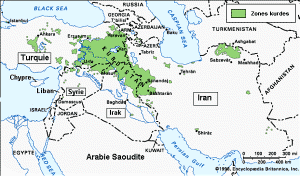
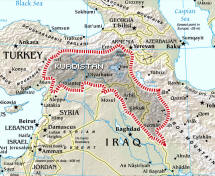
The Heavenly Mountain
There is much more, however, for it is not just the Iranian and Jewish races that cite Kurdistan as the cradle of civilization.
The mythologies of both the Sumerians, who ruled the various Mesopotamian city-states from around 3000 BC onwards, and their eventual conquerors, the Akkadians, placed the homeland of the Gods in this exact same region.
The Akkadians originated as a Semitic, or proto-Hebrew, race of uncertain origin, and in their religious literature this heavenly abode is referred to as Kharsag Khurra, the heavenly mountain. Here the Gods, also known as the Anannage, lived in a paradisiacal realm with gardens, orchards, temples and irrigated fields that not only resemble the Seven Heavens described in the Book of Enoch, but is actually referred to on more than one occasion as edin, the Akkadian for ‘steppe’ or ‘plateau’.
Even further linking Kharsag with the Jewish domain of angels is the knowledge that the Anannage, like the Enochian Watchers, were governed by a council of seven.
These undoubtedly equate with the seven archangels of post-exilic Judaism as well as the six so-called Amesha Spentas, or ‘bounteous spirits‘, who with the supreme God Ahura Mazda, preside over the angelic hierarchies in Iranian tradition.
Were the Anannage, the Gods and Goddesses of Kharsag, simply another form of the Watchers of Enochian and Dead Sea literature, whose homeland was a lofty agricultural settlement called Eden or heaven, located somewhere amid the mountains of Kurdistan?
The Search for Dilmun
Kharsag is not the only name used by the ancient Mesopotamians to refer to their place of first beginnings. This cradle of civilization was also known by the name Dilmun, or Tilmun.
Here, it was said, the God Ea and his wife were placed to institute ‘a sinless age of complete happiness’. Here too animals lived in peace and harmony, man had no rival and the God Enlil ‘in one tongue gave praise’.
It is also described as a pure, clean and ‘bright’ ‘abode of the immortals’ where death, disease and sorrow are unknown and some mortals have been given ‘life like a God’, words reminiscent of the Airyana Vaejah, the realm of the immortals in Iranian myth and legend, and the Eden of Hebraic tradition
Although Dilmun is equated by most scholars with the island of Bahrain in the Persian Gulf, there is evidence to suggest that a much earlier mythical Dilmun was located in a mountainous region beyond the plains of Sumer. But where exactly was it located?
Mesopotamian inscriptions do not say; however, the Zoroastrian Bundahishn text and the Christian records of Arbela in Iraqi Kurdistan both refer to a location named Dilamƒn as having existed around the headwaters of the Tigris, south-west of Lake Van – the very area in which the biblical Eden is said to have been located.
Furthermore, Ea (the Akkadian Enki) was said to have presided over the concourse of Mesopotamia’s two greatest rivers – the Tigris and Euphrates – which are shown in depictions as flowing from each of his shoulders. This would have undoubtedly have meant that the head-waters, or sources, of these rivers would have been looked upon as sacred to Ea by the cultures of Mesopotamia’s Fertile Crescent.
More curious is the knowledge that, as in Hebrew and Iranian myth, there would appear to have been a fall of the Gods of Anu, the Anannage. Whilst 300 of their number remained in heaven, some 600 others, under the leadership of Nergal, God of the underworld, settled among mortal kind. Here they provided mankind with everything from basic agriculture, to astronomy, land irrigation, building technology and structured society.
Sounds familiar?
These rebel Anannage lived ‘in the earth’, a reference to an ‘underworld’ realm connected with the ancient city of Kutha, north of Babylon.
In this ‘House of Darkness‘ lived ‘demons‘ and Edimmu, giant blood-sucking vampires who would return to the surface world after dark to steal the souls of the undead.
- Could these infernal beings be a distorted memory of the rebel Watchers and their monstrous offspring, the Nephilim?
- Might these fallen angels have lived in underground cities after their descent on to the plains?
The Bodies of Birds
Ancient Mesopotamia fathered whole pantheons of devils and demons – each class having its own appearance, functions and attributes.
Some were beneficial to mankind, while others caused only pain, suffering and torment in the mortal world.
In the story of the Goddess Ishtar’s descent to the underworld, preserved in Assyrio-Babylonian tradition, the ‘chiefs’ of the ‘House of Darkness’ were said to have been ‘like birds covered with feathers’, who ‘from the days of old ruled the earth, (and) to whom the Gods Anu and Bel have given terrible names’.
In one cuneiform tablet written in the city of Kutha by a scribe ‘in the temple of Sitlam, in the sanctuary of Nergal ‘ it describes the incursions into Mesopotamia of a race of demons, fostered by the Gods in some nether region.
They are said to have waged war on an unnamed king for three consecutive years and to have had the appearance of:
Men with the bodies of birds of the desert, human beings
with the faces of ravens,
these the great Gods created,
and in the earth the Gods created for them a dwelling…
in the midst of the earth they grew up and became great,
and increased in number,
Seven kings, brothers of the same family,
six thousand in number were their people.
These ‘men with the bodies of birds’ were looked upon as ‘demons’. They would appear only once a storm-cloud had consumed the deserts and would slaughter those whom they took captive, before returning to some inaccessible region for another year
There seems every reason to suggest that these fierce ‘demons‘ were not incorporeal spirits at all, but beings of flesh and blood adorned in cloaks of feathers and bird paraphernalia
But who were these human demons, and how did they relate tothe development of civilization in Mesopotamia?
Uncertain Forces
The Sumerians were a unique people with their own language and culture.
Nobody knows their true origin or where exactly they may have obtained the seeds of knowledge that helped establish the various city-states during the fourth millennium BC. Yet the Sumerians themselves were quite explicit on this point. They said their entire culture had been inherited from the Anannage (the Anunnaki), the Gods of Anu, who had come from an ancestral homeland in the mountains. To emphasize this point they used an ideogram of a mountain to denote ‘the country’, i.e. Sumer, and built seven-tiered ziggurats in honor of these founder Gods.
Was it possible therefore that the proposed Watcher culture of Kurdistan provided the impetus for the rise of western civilization?
Archaeologists have no problem accepting Kurdistan as the cradle of Near Eastern civilization. Shortly after the recession of the last Ice Age, c. 8500 BC, there emerged in this region some of the earliest examples of agriculture, animal domestication, baked and painted pottery, metallurgy and worked obsidian tools and utensils.
Curiously enough, from c. 5750 BC onwards for several hundred years the trade in raw and worked obsidian throughout Kurdistan seems to have been centered around an extinct volcano named Nemrut Dag on the south-western shores of Lake Van, the very area in which both the mythical lands of Eden and Dilmun are likely to have been located.
Kurdistan was undoubtedly the point of origin of the so-called Neolithic explosion from the ninth millennium BC onwards. Indeed, it is because of this settled community lifestyle in Kurdistan that the earliest known form of token bartering developed. This primitive method of exchange eventually led to the establishment of the first written alphabet and ideogram system on the Mesopotamian plains sometime during the fourth millennium BC.
It is therefore understandable that civilization first arose in the Fertile Crescent during this same age. From here, of course, it quickly spread to many other regions of the Old World.
In the light of this information it appears that the evolution of the Middle East seems cut and dry, the actions of a few sophisticated protoneolithic farming communities located in the mountains and foothills of Kurdistan being responsible for the growth of civilized society. Yet what caused this so-called ‘neolithic explosion’, and why on earth did it start in this remote, and very mountainous, region?
Something was missing, for as Mehrdad R. Izady, a noted scholar of Kurdish cultural history, has observed:
The inhabitants of this land went through an unexplained stage of accelerated technological evolution, prompted by yet uncertain forces. They rather quickly pulled ahead of their surrounding communities, the majority of which were also among the most advanced technological societies in the world, to embark on the transformation from a low-density, hunter-gatherer economy to a high-density, food producing economy.
What might these ‘yet uncertain forces’ have been? Were they the Watchers, who were said to have provided mankind with the forbidden arts and sciences of heaven?
If so, was I overlooking important evidence already unearthed by the spades of palaeontologists and archaeologists that might support such a wild hypothesis?
Turning to the archaeological reports and transactions on excavations in Kurdistan, I searched long and hard. What I found astounded me. For instance, in the late 1950s Ralph and Rose Solecki, two noted anthropologists, were uncovering the different occupational levels inside a huge cave overlooking the Greater Zab river at a site known as Zawi Chemi Shanidar, when they made a discovery of incredible significance to this debate.
They unearthed a number of goat skulls placed alongside a collection of wing bones belonging to large predatory birds.
All of the wings had been hacked from the bodies of the birds in question, while many had still been in articulation when found. Carbon 14 dating of the organic deposits associated with these remains indicated a date of 10,870 years (+/-300 years), that is 8870 BC.
The bird wings were subsequently identified as those of four Gyptaeus barbatus (the bearded vulture), one Gyps fulvus (the griffon vulture), seven Haliaetus albicilla (the white-tailed sea eagle) and one Otis tarda (the great bustard) – only the last of which is still indigenous to the region. There were also the bones of four small eagles of indeterminable species. All except for the great bustard were raptorial birds, while the vultures were quite obviously eaters of carrion.
The discovery of these severed bird wings had posed obvious problems for the Soleckis.
Why had only certain types of birds been selected for this purpose, and what exactly had been the role played by these enormous predatory birds in the minds of those who had placed them within the Shanidar cave?
Shaman’s Wings
In an important article entitled ‘Predatory Bird Rituals at Zawi Chemi Shanidar‘, published by the journal Sumer in 1977, Rose Solecki outlined the discovery of the goat skulls and bird remains.
She suggested that the wings had almost certainly been utilized as part of some kind of ritualistic costume, worn either for personal decoration or for ceremonial purposes.
She linked them with the vulture shamanism of Catal Hayuk, a protoneolithic community in central Anatolia (Turkey), which reached its zenith a full 2000 years after these bird’s wings had been deposited 565 miles away in the Shanidar cave.
Rose Solecki recognized the enormous significance of these finds, and realized that they constituted firm evidence for the presence of an important religious cult in the Zawi Chemi Shanidar area, for as she had concluded in her article:
The Zawi Chemi people must have endowed these great raptorial birds with special powers, and the faunal remains we have described for the site must represent special ritual paraphernalia. Certainly, the remains represent a concerted effort by a goodly number of people just to hunt down and capture such a large number of birds and goats…
(Furthermore, that) either the wings were saved to pluck out the feathers, or that wing fans were made, or that they were used as part of a costume for a ritual. One of the murals from a Catal Hayuk shrine … depicts just such a ritual scene; i.e., a human figure dressed in a vulture skin …
Here was extraordinary evidence for the existence of vulture shamans in the highlands of Kurdistan c. 8870 BC!
What’s more, all this was happening just 140 miles south-east of the suggested location for Eden and Dilmun on Lake Van at a time when the highland peoples of Kurdistan were changing from primitive hunter-gatherers to settled protoneolithic communities.
Might these goats skulls and predatory bird remains have some connection with the ‘yet uncertain forces’ behind the sudden Neolithic explosion in this region? Remember, I had already established that the Watchers wore coats of feathers, plausibly those of the crow or vulture
My mind reeled with possibilities.
- What on earth had been going on in this cave overlooking the Greater Zab, which, of course, has been cited as one of the four rivers of paradise?
- Had it been visited by Watchers, human angels, in the ninth millennium BC?
- The presence of the predatory bird remains made complete sense, but what about the fifteen goat skulls – how might they have fitted into the picture?
A Goat for Azazel
The Pentateuch records how each year on the Day of Atonement a goat would be cast into the wilderness ‘for Azazel’, carrying on its back the sins of the Jewish people.
Moreover, Azazel, one of the two leaders of the fallen angels, was said to have fostered a race of demons known as the seirim, or ‘he-goats‘. They are mentioned several times in the Bible and were worshipped and adored by some Jews.
There is even some indication that women actually copulated with these goat-demons, for it states in the Book of Leviticus:
‘And they shall no more sacrifice their sacrifices unto the he-goats (seirim), after whom they go a whoring’, perhaps a distant echo of the way in which the Watchers had taken wives from among mortal kind.
This clear relationship between the Watchers and he-goats is so strong that it led Hebrew scholar J. T. Milik to conclude that Azazel ‘was evidently not a simple he-goat, but a giant who combined goat-like characteristics with those of man’. In other words, he had been a goat-man – a goat shaman.
So it seemed that not only were the Watchers ‘bird-men’, vulture shamans indulging in otherworldly practices, but also goat shamans. It is bizarre to think that this association between Azazel and the goat was the impetus behind the goat becoming a symbol of the devil, as well as the reason why the world is so adverse to the inverted pentagram today.
The Peacock Angel
Kurdish scholar Mehrdad Izady also sees the predatory bird remains of the Shanidar cave as evidence of a shamanistic culture whose memory influenced the development of angel lore.
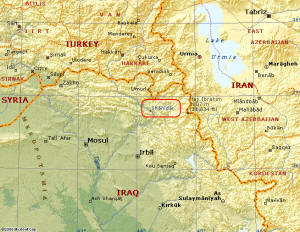
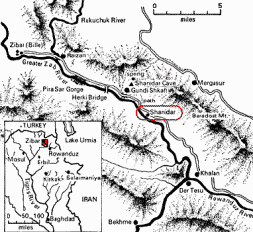
Kurdistan is home to three wholly indigenous angel-worshipping cults – the most notorious and enigmatic of these being the Yezidis of Iraqi Kurdistan.
Their beliefs centre around a supreme being named Melek Taus, the ‘peacock angel’, who is venerated in the form of a strange bird icon known as a sanjaq.
These statues, which sit on a metal column similar to a candlestick, are usually made of copper or brass. More curious is that the oldest known sanjaqs are clearly not peacocks at all, showing instead a bulbous avian body and head with a hooked nose.
Izady has suggested that the sanjaq idols are more likely to be representations of a predatory bird like those apparently venerated by the shamans of Shanidar, in other words either the vulture, eagle or bustard.
The Jarmo People
All this was good news, for its helped vindicate the idea of an advanced culture existing in the mountains of Kurdistan at the point of inception of the Neolithic revolution.
If it was these vulture shamans who had carried this superior knowledge to the gradually developing farming communities of the lower foothills, then perhaps they really were the truth behind the myth of the Watchers who imparted the heavenly sciences to mankind.
There was, however, no description of these shamans beyond the appearance of their ceremonial garments.
Did they in any way resemble the tall, white-skinned individuals with shining countenances and viper-like faces referred to in the Enochian and Dead Sea literature? Might there also be archaeological evidence for the former existence of a race bearing at least some of these distinctive features?
Indeed there is, for at a place called Jarmo, which overlooks the Lesser Zab river in Iraqi Kurdistan, archaeologists have uncovered evidence of an advanced protoneolithic community that thrived from around 6750 BC for up to 2000 years; indeed, the oldest known examples of primitive metallurgy have been found at Jarmo.
More interesting is the knowledge that these people were a dab hand at producing small sculpted images in slightly-baked clay.
Literally thousands of these figurines have been unearthed from the earliest occupational levels upwards. Most of them depict animals and birds. Some represent typically human heads, while others show a female figure, plausibly a representation of the Mother Goddess.
It almost appeared as if the Jarmo community enjoyed capturing images of the world around them, in much the same way that we take photographs today. Yet if this was the case, then how can we explain the presence among these small figurines of several anthropomorphic heads with elongated faces, slit eyes and clear ‘lizard’, or more correctly serpentine features? They are virtually inhuman in appearance and have more in common with bug-eyed aliens than abstract human forms.
Seeing pictures of these Jarmo heads sent a shiver down my spine, for the better examples bore striking similarities to the description of Watchers in Enochian and Dead Sea literature.
- Was it therefore possible that the neolithic people of Jarmo were depicting in partially abstract form the viper-like faces of the tall strangers in feather coats who would pay them uninvited visits?
- Was it these strangers who had provided communities like the one at Jarmo with the knowledge of metallurgy as well as the basic rudiments of agriculture?
- We can only speculate, but it is worth pointing out that obsidian tools found at Jarmo are known to have been fashioned from raw material obtained from the base of Nemrut Dag on Lake Van. Did the Watchers deal in obsidian?
- Might these finely-worked tools be a sign of their presence among other similar-like communities of Kurdistan?
The Serpent People
By 5500 BC the inhabitants of the Kurdish foothills were beginning to descend in great numbers on to the plains of Mesopotamia.
It was around this date that Eridu (the biblical Erech), the Fertile Crescent’s first city, was established with its own temple complex that included an underground ritual pool.
Sometime around 5000 BC saw the arrival on to the northern plains of Mesopotamia of a new culture who are known today as the Ubaid (after Tell al-‘Ubaid, the mound-site where their presence was first detected during excavations by the eminent Near Eastern archaeologist Sir Leonard Woolley in 1922).
They brought with them their own unique artistic style and funerary practices, including the habit of placing very strange anthropomorphic figurines in the graves of the dead.
The statuettes were either male or female (although predominantly female), with slim, well-proportioned naked bodies, wide shoulders, and strange reptilian heads that scholars generally refer to as ‘lizard-like’ in appearance.
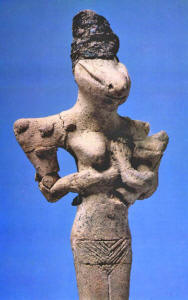
They bear long, tapered faces like snouts, with wide, eye-slits – usually elliptical pellets of clay pinched to form what are known as ‘coffee-bean’ eyes – and a thick, dark plume of bitumen on their heads to represent a coil of erect hair (similar coils fashioned in clay appear on some of the heads found at Jarmo).
All statuettes display either female pubic hair or male genitalia.
Each Ubaid figurine has it own unique pose. By far the strangest and most compelling shows a naked female holding a baby to her left breast. The infant’s left hand clings on to the breast, and there can be little doubt that it is suckling milk. It is a very touching image, although it bears one chilling feature – the child has long slanted eyes and the head of a reptile.
This is highly significant, for it suggests that the baby was seen as having been born with these features. In other words, the ‘lizard-like’ heads of the figurines are not masks, or symbolic animalistic forms, but abstract images of an actual race believed by the Ubaid people to have possessed such reptilian qualities.
In the past these ‘lizard-like’ figurines have been identified by scholars as representations of the Mother Goddess – a totally erroneous assumption since some of them are obviously male – while ancient astronaut theorists such as Erich von Daniken have seen fit to identity them as images of alien entities. In my opinion, both explanations attempt to bracket the clay figurines into popular frameworks that are insufficient to explain their full symbolism.
Furthermore, since most of the examples found were retrieved from graves, where they were often the only item of any importance, Sir Leonard Woolley concluded that they represented ‘chthonic deities‘ – that is, underworld denizens connected in some way with the rites of the dead.
In addition to this realization, it seems highly unlikely that they represent lizard-faced individuals, since lizards are not known to have had any special place in Near Eastern mythology. Much more likely is that the heads are those of serpents which are known to have been associated with Sumerian underworld deities such as Ningiszida, Lord of the Good Tree.
Since the heads of the Ubaid figurines appear to be styled on the much earlier examples found at Jarmo in the Kurdish mountains, were they highly abstract representations of viper-faced Watchers?
That these figurines were found specifically in grave sites suggests that they were connected with some kind of superstitious practice involving rites of the dead.
What were the Ubaid attempting to achieve by placing such strange images alongside their deceased relatives? Were they trying to ensure the safe passage of the soul into the next world, or were they attempting to protect the corpse once the burial had taken place?
In later Babylonian tradition there was a true fear that if the dead were not interred in the correct manner, then their souls would be taken down into the underworld to become blood-sucking Edimmu.
- Is this what the Ubaid feared – that their departed would be made into vampires if the viper-faced Watchers were not appeased in the current manner?
- Did this include the burial of figurines bearing abstract features connected with their distorted memory ofthe fallen race?
Although no trace of any underworld domain can today be found in Mesopotamia, chthonic citadels of extreme antiquity do exist in the Near East.
For example, beneath the plains of Cappadocia in eastern Turkey there are no less than 36 underground cities, the most famous being the one at Derinkuyu which is estimated to have housed some 20,000 inhabitants.
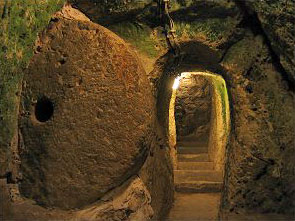
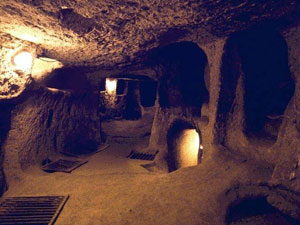
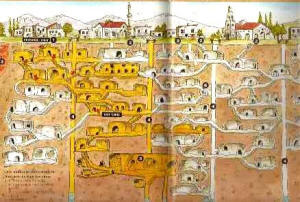
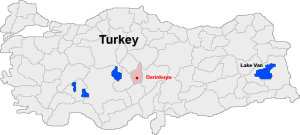
Those cities explored so far penetrate downwards for anything up to a quarter of a mile.
They have streets, complex tunnel systems, living quarters and communal rooms and areas. Each one can be sealed off from the outside world by rolling into place huge circular doors, while on the surface the only visible sign of their presence are upright megalithic stones marking the positions of deep wells that double-up as air shafts to the various levels.
No one knows who built these underworld domains.
They are at least 4000 years old, while tentative evidence suggests they were constructed as early as 9000 BC, when the final thrust of the last Ice Age was about to bring arctic-style conditions to the Middle East.
At the same time rains of fire spewed out of active volcanoes, and when the Ice Age finally receded floods comparable with the deluge of the Bible wreaked havoc in low-lying areas. Moreover, Persian myth records that the ancestors of the Iranian race had escaped the long winter of snow and ice by building a var, a word denoting an underground city (curiously, the word ark means ‘city’ in the Persian language).
The memory of such subterranean worlds are also likely to have been behind the Judaeo-Christian belief in Gehenna and Hell – the fiery realm into which the fallen angels were cast as a punishment for their interference in the affairs of mankind.
Cappadocia’s Lunar Landscape
In the same general vicinity as the underground cities of Cappadocia is a virtual lunar landscape made up of thousands of enormous rock cones whittled into shape by fierce winds over many thousands of years.
Local tradition refers to them as peri bacalari, the fire chimneys of the Peri – beautiful fallen angels born of Iblis, the Arab-Persian form of Satan.
These ‘fairy chimneys’, as they are inappropriately referred to in English, are today said to be haunted by the djinn, spectral relatives of the angels who also once lived in heaven before their fall.
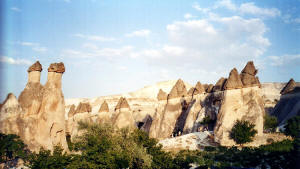
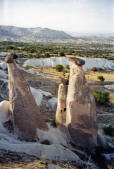
Many of these ‘fairy chimneys‘ were occupied during early Christian times, while a number of them were actually fashioned into rupestral or troglodyte churches from the sixth century onwards.
The oldest contain many fascinating images beyond the accepted iconography of the Early Church. These include recurring geometric designs and, in one case a stylized bird-man, which may well reflect an art-style found in the 8000-year-old vulture shrines at Catal Hayuk.
The close proximity of both this unique ‘Christian‘ art and the site of Catal Hayuk to the underground cities cannot be overlooked.
Remember too that in the story of Ishtar‘s descent into the underworld, the Goddess encounters beings ‘like birds covered with feathers’, who ‘from the days of old ruled the earth’.
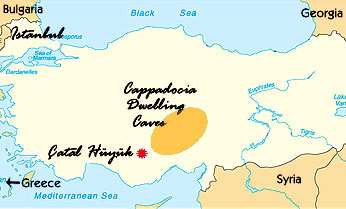
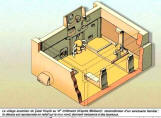
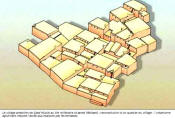
- Is it possible that the dwellers of the underground cities were indeed the forerunners of those who built the sub-surface citadel of Catal Huyuk?
- Might they have been connected with the shamanistic Watcher culture of the Kurdish highlands, which lay some distance to the east of Cappadocia?
Children of the Djinn
If so, then where might these strange shamanistic cultures have originated? Did it simply develop in Turkey and Kurdistan shortly after the end of the last Ice Age, or had its original ancestors migrated from some foreign land?
The angel-worshipping cults of Kurdistan see themselves only as descendents of the patriarch Noah, the savior of humanity whose direct family settled in their land. In contrast, the Kurdish Jews preserve a very curious story concerning the origins of their gentile neighbors, whom they refer to as ‘children of the djinn’.
They say that long ago King Solomon ordered 500 djinn to find him 500 of the most beautiful virgins in the world. They were not to return until every last one was in their possession.
The djinn had set about their immense task, going to Europe to seek out the maidens. Finally, after gathering together the correct number, the djinn were about to return to Jerusalem when they learnt that Solomon had passed away. In a dilemma, the djinn decided what to do. Should they return the girls to their rightful homes in Europe, or should they remain with them?
Because the young virgins had ‘found favor in the eyes of the jinn, the jinn took them unto themselves as their wives. And they begot many beautiful children, and those children bore more children … And that is the way the nation of the Kurds came into being’
In another version of the same story, 100 genies are dispatched by Solomon to search out 100 of the world’s most beautiful maidens for his personal harem. Having achieved this quota, Solomon then dies and the 100 genies decide to settle down with the maidens amid the inaccessible mountains of Kurdistan. The offspring of these marriages result in the foundation of the Kurdish race, ‘who in their elusiveness resemble their genie forefathers and in their handsomeness their foremothers’.
As non-sensical as these legend may seem, they attempt to explain the inexplicable foreign features of certain Kurdish communities and point to their origin in the biblical kingdom of Solomon, in other words modern-day Israel.
Mountain of the Madai
The Mandaeans of Lower Iraq are more specific about the origin of their race.
Although their direct ancestors are said to have come from a mythical location known as the Mountain of the Madai in Iranian Kurdistan, before that their most distant ancestors apparently originated in Egypt. Even though this might seem a mere fantasy on the part of the Mandaeans, it is a fact that their language contains various words that are undoubtedly of ancient Egyptian origin.
More importantly, they believe that after death the soul flies north (i.e. towards the mountains of Kurdistan) where it enters a mythical domain known as Mataratha, the place of judgment. Here the intelligences of the neter, the watch-houses, can be found.
The term neter can be used as a noun in some Near Eastern languages to mean ‘watchers’, the very name of the first angels given in Enochian and Dead Sea literature, while in the ancient Egyptian language this same word is used to define the semi-divine beings who lived in a golden age known as zep tepi, the First Time.
Was it possible that the Watchers of Kurdistan were descendents of the neter-Gods of Egypt?
The First Farmers
Although the neolithic explosion is known to have begun in the mountains of Kurdistan sometime around 8500 BC, this was not the genesis of early agriculture, animal domestication, precision tool manufacture and structured community lifestyles.
There is strong evidence that they were all present at various sites along the Nile in southern Egypt and northern Sudan as early as 12,500 BC. These advanced communities continued to develop at a steady pace until 10,500 BC, when suddenly they ceased farming for no obvious reason.
Scholars have put this complete and utter cessation of a sophisticated agricultural-based lifestyle among the Nilotic peoples down to the extremely high Nile floods which occurred during this epoch. Yet in my opinion there was something more behind this extraordinary U-turn on the part of these communities.
It almost seemed as if those who had taught the Nilotic peoples the rudiments of an agricultural lifestyle had suddenly departed the scene, leaving their obedient pupils to return to primitive hunter-gatherer lifestyles more familiar to the age in question.
It is therefore interesting to note that after its apparent disappearance from Egypt c. 10,500 BC, agriculture does not reappear again until it blossoms in Kurdistan a full 1500 years later.
- Is it therefore possible that the teachers of the Nilotic communities departed Egypt for Kurdistan sometime between 10,500 and 9000 BC?
- Who exactly were these hypothetical agronomists and what made them leave the cultivated steppes of palaeolithic Egypt for pastures new?
- More importantly, were they the ancestors of the Watchers, the human angels of Enochian and Dead Sea tradition?
Redating the Sphinx
Hard evidence now emerging from Egypt strongly suggests that the Great Sphinx of Giza was not carved during Pharaonic times, as has always been believed, but much earlier instead.
As has been widely publicized over the past few years, the geological profile of this most ancient of monuments suggests that it was fashioned before the gradual desiccation of the Middle East in the fourth millennium BC.
The intense weathering on its body would appear to have been induced, not by sand erosion, but by rain precipitation over the course of many thousands of years. The last time that rain fell in such profusion was during the period known to climatologists as the neolithic sub-pluvial which occurred between 8000 and 5000 BC. This suggests that the Sphinx was carved either during or before this time.
The Sphinx is quite obviously a lion, the head of which was re-carved in Pharaonic times to represent a king wearing the nemes-headdress. Orientated exactly due east, it gazes out towards the point on the horizon where the sun rises each spring and autumn equinox. Its function is like that of a time-marker, a minute hand on a clock, recording the return of the solar orb as it passes through its 365-day cycle.
Yet it also possesses a less obvious, though perhaps more important ‘hour’ hand, and this one marks the minuscule shift in the starry canopy as it turns about its 26,000-year cycle of precession.
This visual effect is caused by the extremely slow wobble of the earth, which might be compared with the swaying action of a child’s spinning top if revolving at a snail’s pace.
Built in the Age of Leo
In astronomical terms the phenomenon known as precession causes the 12 zodiacal constellations to shift backwards in line with the ecliptic, the sun’s path, in a regular sequence.
In simple terms, this means that the stars rising alongside the sun make way for another constellation every 2160 or so years until all 12 signs have completed this astronomical merry-go-around.
To ‘read’ precession as a long-term time-cycle the ancients noted which sign rose with the sun on the spring equinox, the zero-point of the yearly calendar in many Middle Eastern cultures.
If we look today towards the eastern horizon just before sun-rise on 21 March we will see the stars of Pisces. When Alexander the Great conquered the Persian Empire in 330 BC, the stars of Aries the ram were seen rising with the equinoctial sun, and when the Pyramids of Giza were built in c. 2500 BC, it was the stars of Taurus the bull that rose with the sun on the spring equinox.
If the Great Sphinx was carved as an equinoctial marker at the same time the neighboring Pyramids were constructed in Pharaonic times, then surely it would make more sense if it was a bull. Making it a lion hints at a connection with the stars of Leo, suggesting that it marked an age when the constellation of Leo rose with the equinoctial sun.
The last Age of Leo occurred between 10,970 and 8810 BC, suggesting that the construction date of the Great Sphinx fell somewhere within this time-frame. This is not a new idea by any stretch of the imagination.
As far as I am aware, this theory was first put forward by British astro-mythologist Gerald Massey in 1907.
In an extraordinary work entitled ANCIENT EGYPT – THE LIGHT OF THE WORLD he boldly concluded that,
‘… we may date the Sphinx as a monument which was reared by these great (Egyptian) builders and thinkers, who lived so largely out of themselves, some thirteen thousand years ago (i.e. in the age of Leo, its astronomical counterpart).’
More recent astro-mythological evidence presented by Graham Hancock and Robert Bauval in their 1996 book KEEPER OF GENESIS, convincingly demonstrates that the Great Sphinx, as well as the ground-plan of the Giza plateau as a whole, must date as early as 10,500 BC, the very time-frame given for the sudden cessation of proto-agriculture along the Nile.
Since we know that the great stone blocks removed from the sunken enclosure around the leonine monument at the time of its construction were used to build the nearby Sphinx and Valley Temples, then these too must date from the same distant epoch of human history.
All this indicates the presence in Egypt around 10,500 BC of an advanced culture adept in agronomy, engineering, building technology, as well as astro-mythology and geomythics that included a profound knowledge of the earth’s 26,000-year precessional cycle.
- Who were these people?
- Were these builders of the Great Sphinx really the ancestors of the tall, viper-faced Watchers of Kurdistan?
- Folklore, legend and the spread of Old World agriculture would appear to support this view. Yet if this was the case, then what happened to make this Egyptian Elder culture want to migrate to the highlands of Kurdistan?
Global Destruction
As has already been adequately demonstrated elsewhere (Hapgood, 1958 & 1970; Hancock, 1995; Flem-Ath, 1995), there is ample evidence that as the last Ice Age came to a close in the eleventh and tenth millennia BC, the world was shaken by a series of severe climatic changes and geological upheavals.
Volcanoes erupted, earthquakes shook the ground, floods poured across the landscape and long periods of darkness blotted out the sun. This led to the destruction of countless millions of animals and the outright extinction of dozens of individual species. Cataclysm legends across the world appear to record these events in colourful and often symbolic detail.
Egypt’s proposed Elder culture would have been right in the thick of this global destruction.
Certainly it is known that the climatic changes during this epoch caused wide-spread flooding along the Nile, the reason scholars have suggested for the cessation of its proto-agriculture.
Father of Terrors
It seems likely that these troubled times forced Egypt’s high culture to fragment and disperse, hence the sudden cessation of proto-agriculture among the various Nile communities.
This supposition is supported by vivid accounts of fire and flood from Egypt itself. For example, surviving Coptic-Arab texts speak of the land being devastated both by floods and a great fire that came from ‘the constellation of Leo’ – a reference not necessarily to some astronomical boloid coming from this part of the heavens, but to the time-frame in which these events occurred, in other words during the Age of Leo.
More telling is the myth of Sekhmet, the lion-headed deity in the Egyptian pantheon. Because the human race had turned its back on the ways of the sun-God Ra, or Re, whom it saw as ‘too old’, the fierce Goddess unleashed an all-consuming fire. Her mass genocide would have resulted in the destruction of humanity had it not been for Ra’s personal intervention. He sent an intoxicating brew to cover the earth. Consuming this mixture made Sekhmet drunk so that she fell asleep.
Assuming that Sekhmet’s fierce fire was in some way representative of an all-encompassing conflagration that devastated Egypt, then might the intoxicating brew that covered the earth be a memory of a subsequent flood that also overwhelmed the land? If so, then was Sekhmet herself simply a allegorical allusion to the Age of Leo?
The indications are that the lion of Leo come to symbolize the age of chaos and destruction that surrounded the end of the Ice Age, perhaps the reason why the Arabs referred to the Great Sphinx as the ‘Father of Terrors‘.
In the story of Sekhmet the survivors of the human race attempt to escape the Goddess‘ devastating fire either by climbing a mountain or by hiding in ‘holes’ like ‘snakes’ or ‘worms’. Similar means of protection against the cataclysms that raged during the Age of Leo are found in mythologies around the globe, while the presence of such stories in Egyptian legend point towards the break-up of the Elder culture and its subsequent re-establishment in other regions.
Might this have included Cappadocia, where underground cities would appear to have been built as early as 9000 BC, and the mountains of Kurdistan, where the Watchers may well have catalyzed the beginning of the Neolithic revolution as early as 8500 BC?
The date for this apparent Diaspora of the Elder culture towards the end of the last Ice Age can actually be pinned down with some degree of accuracy.
For instance, a ninth-century Coptic-Arab text known as Abou Hormeis records that the astronomer-priests of Egypt, having realized the imminent destruction of their race, conceded that:
‘The deluge was to take place when the heart of the Lion entered into the first minute of the head of Cancer.’
The ‘heart of the lion’ was the name given in classical times to the star Regulus, Leo’s ‘royal star’, which lies exactly on the ecliptic, the sun’s perceived daily course across the sky.
Since the constellation of Cancer follows Leo only in the precessional cycle (Leo follows Cancer in the yearly cycle), then this appears to confirm that this legend preserved, not just the memory of probable historical events, but also the approximate date in which they occurred.
At my request, electronics engineer Rodney Hale punched the astronomical information contained in the Abou Hormeis account into a computer using a Skyglobe 3.5 programme. He ascertained that the last time Leo’s ‘royal star’ would have risen and been visible on the eastern horizon just prior to the equinoctial sunrise, was around 9220 BC.
When the star Regulus, the ‘heart of the lion’, no longer rose with the sun on the spring, or vernal, equinox, this would have been seen by the astronomer-priests of Egypt as a signal that the Age of Leo had come to an end, and the age of Cancer was either about to commence, or that it had already entered its ‘first minute’ of arc across the sky.
This information therefore suggested that it was at this point that the Elder culture had departed Egypt in anticipation of a major deluge that was about to over-run their land.
Kosmokrator
If we now turn to Iranian tradition we find that various Zoroastrian texts, including the Bundahishn, speak of world history beginning 9000 years before the traditionally accepted date for the coming of its great prophet, Zoroaster, in 588 BC.
This gives a date of 9588 BC. It was at this time, so one text states, that the faith’s dualistic deities, Ahura Mazda and Angra Mainyu, were born from ‘the fire of the air’ and ‘the water of the earth’ – cryptic references once again to fire and flood during the age of Leo.
The twin deities vie for superiority over heaven and earth, a battle that is only settled when Zoroaster is said to have vanquished the daeva-worshipping Magi priesthoods during his own life-time. Ever since this time the ‘Good Spirit’, Ahura Mazda, has ruled supreme.
Did all this imply that the ancestors of the Iranian God-kings had first inhabited their mythical homeland, known as the Airyana Vaejah, the Iranian Expanse, around 9588 BC? Give or take a few centuries, this date was remarkably close to the time-frame in which the Egyptian Elder culture would appear to have broken up.
Since the Airyana Vaejah is equated with the Kurdish highlands, might this tradition also record the arrival in the region of those Elders who went on to establish the proposed Watcher culture?
According to Iranian mythology, the dualistic forces of Ahura Mazda and Angra Mainyu were born to a supreme being known as Zurvan, who symbolized ‘infinite time’. In the Roman cult of the God Mithras, which developed from primary Iranian sources, the concept of ‘infinite time’ was symbolized by a lion-headed deity. Statues depicting this leonine figure show the twelve signs of the zodiac on its chest and a snake curling up over the top of its mane.
Although the deity is not identified by name (although it is occasionally linked with Aeon, a gnostic God of time), scholars of Mithraism describe it as a kosmokrator, the controlling intelligence behind the phenomenon of precession.
To find a lion-headed kosmokrator that originated in a tradition that saw world history as having begun in 9588 BC, during the Age of Leo, was impossible to ignore. Could it be possible that although knowledge of the precessional cycle was understood by the Elder culture of Egypt, later cultures who inherited this tradition failed to comprehend its mechanics.
So instead of Leo making way for the age of Cancer, and then Gemini, and then Taurus, the symbol of the lion became the one and only kosmokrator, or guardian of infinite time, in much the same way that the Great Sphinx became a precessional time-marker on the plateau at Giza.
Tragedy of the Fall
Egypt’s Elder culture never made it into the pages of history.
The memory of their apparent descendents, the Watchers of Kurdistan, is but a hollow victory on their part.
Being remembered as beautiful angels who fell from grace, or as immortal Gods and Goddesses, or as lustful demons who corrupted the minds of mankind, hardly befits their incredible achievements in astronomy, agriculture, geomythics, building technology and structured society. It was almost certainly the descendents of the Egyptian Elder culture who paved the way for the growth of civilization in the Old World.
Yet these individuals did much more than this, for they would also appear to have left the world an important legacy. It can be traced in the astro-mythology and geomythics of the Giza plateau as well as in the universal myths and legends concerning global cataclysms and precessional data.
It transcends all language barriers and can be ‘read’ by all. It is a simple message repeated again and again, like a recurring SOS Mayday signal, and it suggests that what befell their race could one day happen again.
For whatever reason, we as a race could sink into oblivion without trace and be wiped clean from the pages of history, unless, that is, we wake up from this collective amnesia we seem to have been experiencing for the past eleven thousand years and realize that we were never the first.
Free thinkers, mystics and maverick scholars have been telling us that civilization is much older than science would like us to believe for the past hundred years or more.
Often their books repeat almost exactly the same evidence time after time. The Pyramids, Tiahuanaco, the Maya, Piri Reis, Hapgood, Plato and the Baghdad battery are just some of the buzz-words repeated again and again. Yet no one other than believers has ever taken these matters seriously.
With the re-dating of the Great Sphinx in particular, there is now too much evidence to deny that at the end of the last Ice Age a high culture existed in this world. Where these people came from is completely unknown. Some might suggest Atlantis, others will say they came from the skies, but to be honest we simply do not know.
What is far more important is that we take each step at a time, and stick to hard facts, in the hope that this time the whole world will share in these greatest revelations of our time.
Selected Booklist
- Bauval, Robert, and Graham Hancock, Keeper of Genesis, Wm Heinemann, London, 1996
- Boyce, Mary, A History of Zoroastrianism, 1975, 3 vols., E. J. Brill, Leiden, 1989
- Charles, R. H., The Book of Enoch or 1 Enoch, Oxford Univ Press, 1912
- Eisenman, Robert H., and Michael Wise, The Dead Sea Scrolls Uncovered, Element, Shaftesbury, Dorset, 1992
- Flem-Ath, Rand and Rose, When the Sky Fell – In Search of Atlantis, Weidenfeld & Nicolson, London, 1995
- Fix, William R., Pyramid Odyssey, Jonathan-James Books, Toronto, Ontario, Canada, 1978
- Hancock, Graham, Fingerprints of the Gods – A Quest for the Beginning and the End, Wm Heinemann, London, 1995
- Hapgood, Professor Charles, The Path of the Pole, Chilton, New York, 1970
- Hapgood, Professor Charles, Maps of the Ancient Sea Kings, 1966, Turnstone Books, London, 1979
- Izady, Mehrdad R., The Kurds – A Concise Handbook, Crane Russak, London, 1992
- Massey, Gerald, Ancient Egypt – The Light of the World, 2 vols., T. Fisher & Unwin, London, 1907
- Milik, J. T., The Books of Enoch – Aramaic Fragments of Qumrƒn Cave 4, OUP, 1976
- Morfill, W. R., trans., edit and intro R. H. Charles, The Book of the Secrets of Enoch, Oxford Univ Press, 1896
- Ulansey, David, The Origins of the Mithraic Mysteries – Cosmology and Salvation in the Ancient World, OUP, 1989




